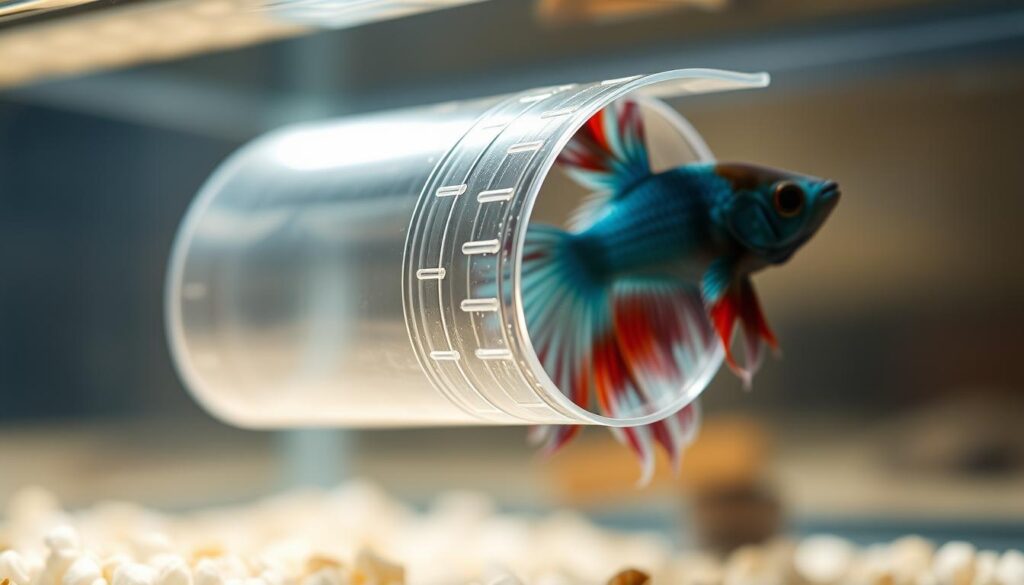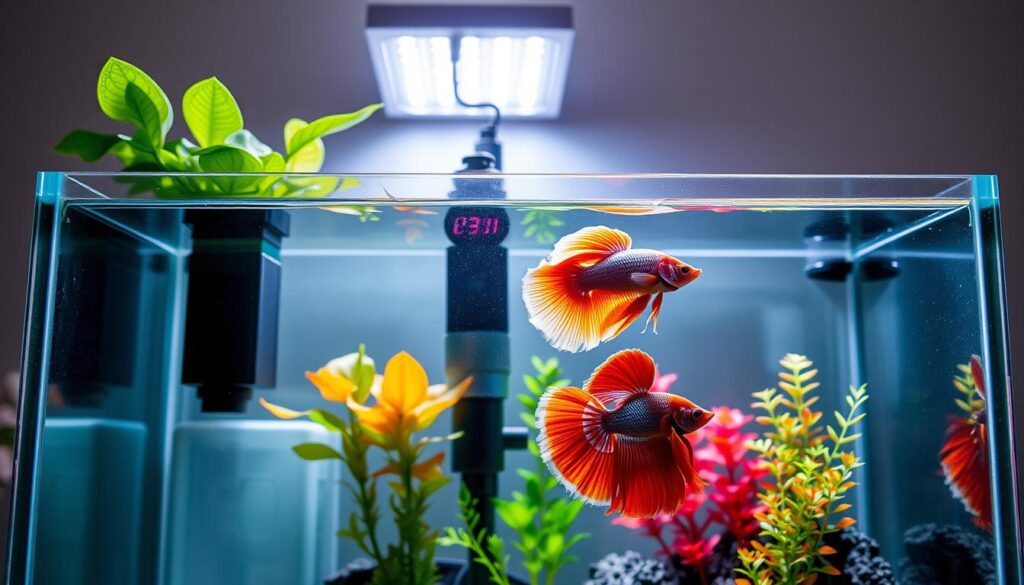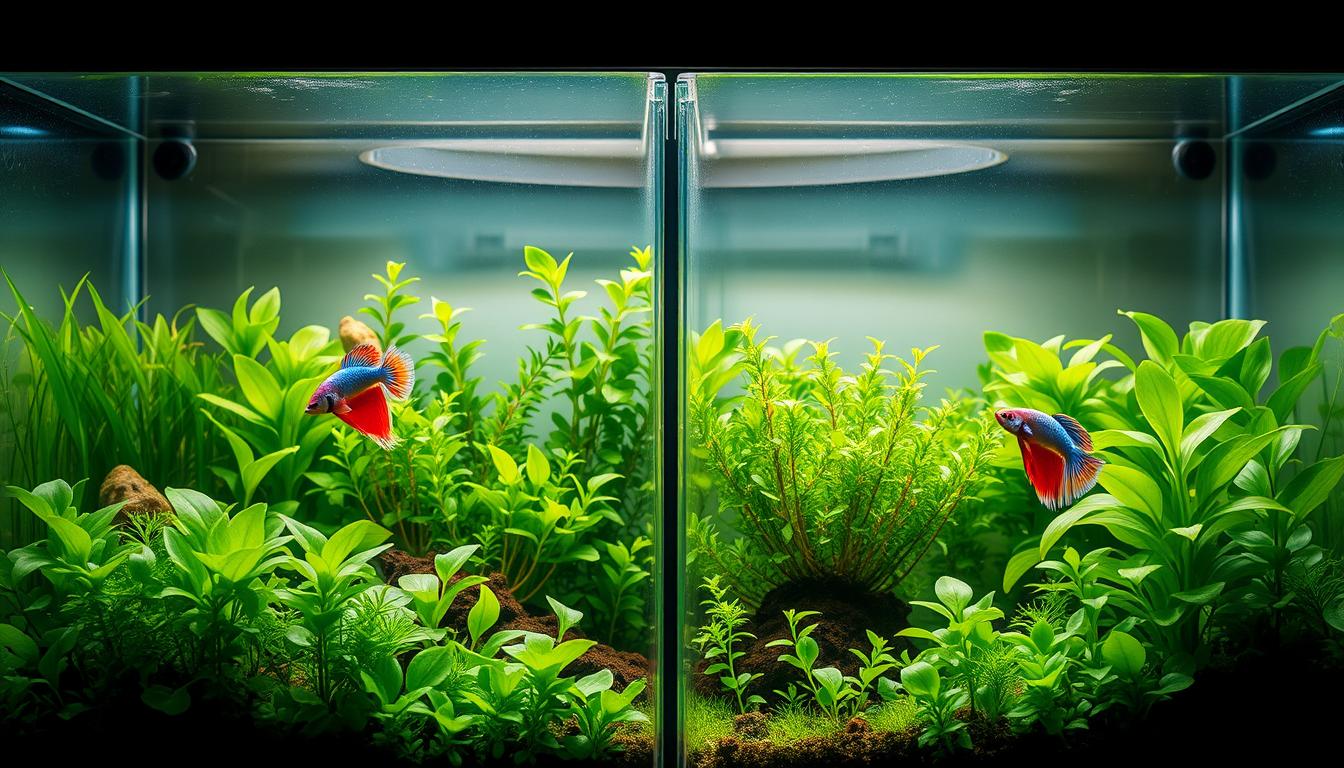A Betta fish divided tank might sound like the perfect solution—one tank, two beautiful bettas, and no fighting, right? Well, it can be, but only if it’s done correctly. Bettas are territorial by nature, especially males, and placing them too close without proper separation can cause serious stress or aggression.
A Betta fish divided tank allows you to house two (or more) bettas in one aquarium with a secure divider that blocks both physical contact and line of sight. In this guide, we’ll walk you through everything you need to know about setting up a Betta fish divided tank, including divider types, tank size requirements, pros and cons, and safety tips to ensure each fish stays healthy and happy.
Key Takeaways
- Create a harmonious environment for multiple betta fish
- Reduce stress and fights among betta fish
- Promote the overall well-being of your betta friends
- Learn tips on setting up a divided tank
- Discover the benefits of a harmonious aquatic habitat
Understanding Betta Fish Behavior and Housing Needs
To make a happy home for your betta fish, knowing their behavior and needs is key. Betta fish have unique personalities and like to own their space. This makes it tricky to house them.
The Territorial Nature of Betta Fish
Betta fish are naturally territorial. In the wild, they fight to keep their territory safe from others. This behavior is important when setting up their tank to avoid fights and stress.
Why Traditional Community Tanks Often Fail for Bettas
Traditional tanks don’t work well for betta fish because of their territorial nature. Keeping betta fish with others can lead to fin nipping, stress, and sickness.
Benefits of Divided Tank Solutions
Divided tanks are a smart way to keep multiple betta fish together safely. Some good things about them are:
- Less fighting among betta fish
- Less stress because of the barriers
- More than one betta fish can live in one tank
Understanding betta fish behavior and needs helps us create a great home for them. This knowledge is essential for keeping your betta fish happy and healthy.
Planning Your Betta Fish Divided Tank
Let’s explore the world of betta fish divided tanks. We’ll see how to plan the perfect setup for your finned friends! Creating a harmonious environment for multiple betta fish requires careful consideration of several key factors.
Minimum Tank Size Requirements
The general rule for housing betta fish is a tank of at least 5 gallons. But, we suggest going bigger if you can! A larger tank means more stable water and plenty of swimming space for your betta fish. So, for multiple betta fish, aim for a tank of 20 gallons or more. This ensures each fish has its own comfortable territory.

Optimal Division Configurations
The way you divide your tank is crucial for your betta fish’s well-being. You can use solid or mesh dividers, depending on your needs. Solid dividers separate environments completely, while mesh dividers allow for water circulation. Think about what’s best for your setup and your betta fish’s behavior!
Water Volume Considerations Per Betta
Each betta fish needs its own space, and water volume is key. Aim for at least 5 gallons per betta for enough swimming room and stable water conditions. This also makes caring for your fish easier, as larger volumes are more forgiving if you miss a water change or two.
Determining How Many Bettas to House
The number of betta fish you can house depends on your tank’s size and division configurations. As a general guideline, ensure each compartment is large enough for your betta fish to swim comfortably. Don’t overcrowd your tank – it’s better to provide a comfortable environment for a few fish than to overcrowd and risk stress and disease.
By carefully planning your betta fish divided tank, you can create a thriving environment. This environment will showcase the unique personalities of your betta fish. Happy planning, and don’t hesitate to reach out if you have any questions or need further guidance!
Types of Tank Dividers for Betta Fish
Choosing the right divider is key for a happy betta fish tank. There are many options, each with its own benefits and drawbacks. It’s important to pick one that works well for your fish.
Solid vs. Mesh Dividers: Pros and Cons
When picking between solid and mesh dividers, think about your betta’s needs. Solid dividers block your betta’s view of other fish, which can reduce stress. But, they might slow down water movement.
Mesh dividers let water flow better and keep water quality steady. Yet, they might not stop all stress from seeing other fish.
| Divider Type | Pros | Cons |
|---|---|---|
| Solid Dividers | Complete barrier, reduces stress | Impides water circulation |
| Mesh Dividers | Allows for water flow, maintains water parameters | May not eliminate stress completely |
DIY Divider Options and Instructions
Making your own divider is a fun and budget-friendly project. You can use plastic, glass, or acrylic. You’ll need a cutting tool and aquarium-safe glue.
Measure your tank, cut the material, and glue it in place. It’s a simple way to create a divider.

Commercial Divider Products Review
If DIY isn’t your style, there are many commercial dividers. Look for ones made from safe, durable materials. Some have adjustable sizes or are made just for betta tanks.
Securing Dividers Properly
It’s important to secure your divider well. Make sure it fits tightly against the tank walls and bottom. Check it often for damage or wear.
Read Also How Big of a Tank Does a Betta Fish Need? The Honest Answer for a Happy Betta
Essential Equipment for a Successful Betta Fish Divided Tank
Now that we’ve explored the benefits of divided tanks, let’s dive into the essential equipment you’ll need. Creating a thriving environment for your betta fish involves more than just a tank and dividers.
Filtration Systems for Divided Tanks
A good filtration system is crucial for maintaining clean and healthy water across all compartments of your divided tank. You can opt for a single, powerful filter that serves the entire tank or individual filters for each section. When choosing a filtration system, consider the size of your tank and the number of bettas you’re housing. A hang-on-back filter or a canister filter can be an excellent choice for divided tanks as they provide efficient mechanical and biological filtration.

Heating Solutions Across Compartments
Betta fish are tropical and require warm water to thrive. To maintain a consistent temperature across all compartments, you can use a single, submersible heater placed in the center of the tank or individual heaters for each section. It’s essential to choose heaters that are suitable for the size of your tank and have a reliable thermostat to prevent overheating. Always follow the manufacturer’s guidelines for heater placement and wattage.
Lighting Considerations
Lighting is not just about aesthetics; it plays a crucial role in the health and well-being of your betta fish. For a divided tank, you can use a single light source or individual lights for each compartment. LED lights are a popular choice due to their energy efficiency and the ability to customize their spectrum. Be cautious not to overlight, as this can lead to algae growth and stress on the fish.
Water Testing Equipment
Regular water testing is vital to ensure the health of your betta fish. You’ll need a reliable water test kit that can measure parameters such as pH, ammonia, nitrite, and nitrate levels. API Freshwater Master Test Kit is a popular choice among aquarium hobbyists. Regular testing helps you identify any issues early, allowing you to make adjustments before they become major problems.
By investing in the right equipment and maintaining a consistent maintenance routine, you can create a thriving environment for your betta fish. Remember, a happy betta is a healthy betta!
Creating Individual Territories in Your Betta Fish Divided Tank
Exploring betta fish divided tanks, we learn to create special spaces for them. You might ask, “Why separate areas for my betta fish?” It’s to reduce stress and improve their well-being.
Decorating Each Section Uniquely
Decorating each tank section is more than just making it look good. It’s about creating a special environment for each betta. Use different decorations, plants, and substrates to give each section its own character. For example, you can have a “cave” section or a “garden” section.
Tip: Mix tall and short plants with decorations like rocks or treasure chests. This adds interest and depth to each section.
Best Plants for Betta Compartments
Choosing plants for your betta compartments is key. Pick ones that are safe and beautiful. Favorites include Java Moss, Anubias, and Amazon Swords. They’re easy to care for and provide hiding spots.
Remember, plants are more than decorations. They’re essential to the ecosystem.
“The right plants can make all the difference in creating a thriving environment for your betta fish.”
Hiding Spots and Enrichment
Betta fish enjoy hiding and playing. So, add hiding spots and enrichment activities to your tank. Use plants, rocks, and toys like ping-pong balls to keep them active.
- Add plants with broad leaves for betta to hide behind
- Use decorative rocks or caves to create hiding spots
- Incorporate toys or other enrichment activities to keep your betta engaged
Substrate Choices and Arrangement
The substrate you choose affects your tank’s look and feel. For betta fish, use a fine-grained substrate like sand or gravel. Arrange it to create a gradient or pattern for visual interest.

By following these tips, you can create a great habitat for your betta fish. Happy decorating, and have fun with it!
Water Quality Management in Divided Setups
Managing water quality in divided betta tanks is a unique challenge. But don’t worry, we’ve got you covered! Keeping each tank section’s water quality optimal is key for your betta fish’s health.
Maintaining Consistent Parameters Across Sections
To keep your betta fish happy, it’s vital to keep water parameters the same in all tank sections. This means checking and adjusting temperature, pH, and levels of ammonia, nitrite, and nitrate. Regular water testing is crucial to catch any imbalances early.
Testing and Monitoring Strategies
Good water quality starts with a solid testing and monitoring plan. Use a top-notch water test kit to check various parameters weekly. Also, watch your betta fish for signs of stress or illness, as these can show poor water quality.
Water Change Protocols
Regular water changes are essential for keeping water quality high. For divided betta tanks, change water in all parts at once to keep it consistent. Aim to replace 25-50% of the tank’s water every week, based on its size and biological load.
Dealing with Ammonia and Nitrate Buildup
Ammonia and nitrate buildup are common in aquariums, including divided betta tanks. To avoid these issues, make sure your tank is cycled before adding fish. Also, consider using beneficial bacteria supplements to keep a healthy balance.
By following these tips and keeping up with water quality, you can create a great home for your betta fish in a divided tank.
Feeding and Care Routines for Multiple Bettas
Feeding multiple betta fish in a divided tank is more than just throwing food in. It’s about creating a routine for each fish. It’s key to develop a feeding plan that meets each fish’s needs without overfeeding or polluting the tank.
Individual Feeding Techniques
To keep your betta fish healthy, feeding them one at a time is best. You’ll need to target feed each compartment or use dividers that let food through but keep fish apart. Target feeding means placing food right in front of each betta, so they eat without stress or competition.
Preventing Cross-Contamination
Feeding multiple bettas can lead to cross-contamination. To avoid this, use a separate feeding utensil for each compartment to stop bacteria or uneaten food from spreading. Also, clean the dividers and tank surfaces often to keep the environment healthy.
Monitoring Health and Behavior
Watching your betta fish’s health and behavior is very important. Look for signs of illness, stress, or tiredness, and be ready to change their diet or environment if needed. Regular checks help you spot problems early, keeping your bettas healthy and happy.
Establishing a Maintenance Schedule
Having a regular maintenance schedule is crucial for your betta fish’s well-being. This includes regular water changes, tank cleaning, and checking equipment. By following a schedule, you’ll keep your tank clean and your bettas healthy!
Common Challenges with Betta Fish Divided Tanks and Solutions
Setting up a Betta fish divided tank can come with challenges. But, we’ve got you covered! Divided tanks are great for housing multiple Bettas. However, they need careful management to keep your fish healthy and happy.
Stress Signs to Watch For
Watch for stress signs in your Betta fish. Look for lethargy, loss of appetite, or frantic swimming. If you see these signs, find and fix the problem quickly.
Divider Jumping and Prevention
Betta fish are known to jump, and dividers might not always stop them. To stop divider jumping, make sure your dividers are secure. Also, consider adding a tank lid.
Managing Aggression Through Visual Barriers
Visual barriers can help reduce aggression between Bettas. They block the fish’s sight. Use plants or decorations to create these barriers and reduce stress.
Troubleshooting Uneven Water Conditions
Regular water testing is key in a divided tank. It ensures water conditions are the same in all compartments. Adjust your water change schedule to keep water quality optimal.
Addressing Disease Spread Between Compartments
Disease can spread fast between compartments if not managed. Quarantine new fish, keep water quality high, and avoid cross-contamination during tank maintenance.
By knowing these common challenges and how to solve them, you can create a thriving Betta fish divided tank. It will showcase the beauty and personality of your fish.
Read Also Betta Fish Stress Stripes: What They Mean and How to Treat Them
Conclusion: Creating a Thriving Multi-Betta Environment
You’ve reached the end of creating a peaceful home for your betta fish! With the right setup and care, a divided tank can showcase multiple betta fish living well together.
This article has shown you how to build a betta fish divided tank. You’ve learned about choosing dividers and keeping water quality perfect. Now, you’re ready to make a happy home for your betta fish.
So, what’s holding you back? Start your betta fish journey and build your dream tank! With effort and knowledge, you’ll soon see the beauty of multiple betta fish. A well-made divided tank is a wonder, and we can’t wait for you to see it!


I conceive you have remarked some very interesting details , thanks for the post.